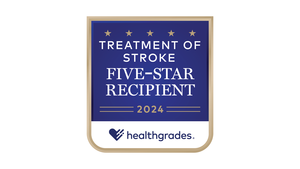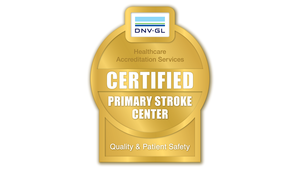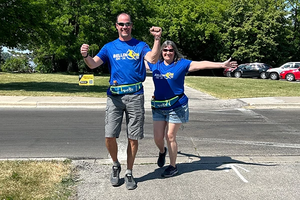
Stroke Center
When it comes to strokes, time is of the essence. That's why it’s crucial to identify the signs and symptoms as quickly as possible.
Recognizing stroke signs and symptoms fast is important as prompt medical help can greatly increase the likelihood of a good result. Time plays an important role because certain treatments, such as administering clot-busting drugs or performing surgery, require a specific timeframe to be effective. The longer the delay in receiving medical attention, the higher the risk of permanent brain damage or disability.
A stroke is often referred to as a “brain attack.” It occurs when the blood supply to the brain is interrupted or reduced, depriving the brain of oxygen and nutrients. This can happen due to a blockage in the blood vessels (ischemic stroke) or when a blood vessel bursts (hemorrhagic stroke).
The lack of oxygen and nutrients can cause brain cells to die, leading to various symptoms and potential long-term disabilities. Acting quickly and seeking medical attention is crucial in minimizing the damage caused by a stroke.
BE-FAST
Remember the acronym BE-FAST, which stands for Balance, Eyes, Face, Arms, Speech and Time.
Balance - Severe dizziness, loss of balance or coordination
Eyes - Sudden vision changes
Face - Face or smile drooping, often sudden onset
Arm - Weakness in arms or legs (especially on only one side of the body)
Speech - Sudden speech difficulty, confusion or talking gibberish
Time - Call 9-1-1 immediately

First, check the person’s face for any drooping or numbness. Ask them to smile and see if one side of their face appears uneven. This could be a sign of a stroke.
Next, assess their arms by asking them to raise both of them. If one arm drifts downward or feels weak, it could indicate a stroke.
Then, evaluate their speech. Ask them to repeat a simple phrase and listen for any slurred or garbled words. Difficulty speaking or understanding can be a clear indication of a stroke.
Finally, note the time when the symptoms started. This information is crucial for medical professionals to determine the best course of action.
If you observe any of these signs, call 911 and get help immediately. Every minute counts in minimizing the damage caused by a stroke. Stay with the person until help arrives, and reassure them that medical assistance is on the way.
Remember, acting fast can make a significant difference in the outcome of a stroke. Recognize signs, act quickly, save lives, prevent disabilities.
You're in Good Hands
Our stroke team and local first responders have collaborated to create a successful stroke program. It guarantees that our stroke patients receive a CT scan within minutes. We take pride in providing timely, coordinated care that delivers the best outcome.
Our awards:
- DNV Certified Primary Stroke Center
- American Heart Association/American Stroke Association’s (AHA/ASA) Get With The Guidelines® Stroke Gold Plus achievement award
- Target: Stroke Honor Roll Elite Plus Award: We are proud to be one of 17 hospitals in the U.S., and one of three in Wisconsin, to receive this award.



Stroke Prevention
The risk factors for heart attack are the same risk factors that can cause stroke.
- High blood pressure is one of the most common causes of stroke. Lowering blood pressure can reduce the risk of stroke by 30-40 percent. High blood pressure is one of the most manageable stroke risk factors.
- High Cholesterol Know your cholesterol number. Cholesterol levels of 240mg/dl or higher increase the risk of stroke and heart attack. High cholesterol, triglycerides and LDL “bad” cholesterol cause atherosclerosis and increase the chance of having a stroke.
- Smoking cigarettes is recognized as a major risk factor for stroke. Smokers have more than twice the risk of stroke than non-smokers.
- Having diabetes increases your risk of fatty plaque building up in your vessels. People with diabetes are at a higher risk of having high blood pressure. This increased risk also raises their chances of having a stroke by four times compared to individuals without diabetes.
- Age is a risk factor. While anybody at any age can have a stroke, your risk increases as you get older. However, keep in mind that nearly one-fourth of all strokes occur in people younger than age 65.
- Gender is also a risk factor since more men than women will have a stroke. But this one is a little misleading because while fewer women have strokes, women are more likely to die from stroke.
- Family history can play a role, including your race.
- If you’ve had a stroke in the past, you’re at higher risk for another one.
Additional Resources
Take Control of Your Health
You can reduce your risk of stroke by managing certain factors, whether it’s your first time or you’ve already had one. Taking control of these factors is important.
- To enhance your overall fitness or get support in adjusting your activity to accommodate lost function, learn more about discounted programs through Bellin Fitness.
- For help with improving your daily diet, consider nutritional counseling.
- For assistance in quitting tobacco, join one of Bellin’s highly successful Smoking Cessation programs.
After a stroke, people often feel different emotions and frustrations, regardless of how serious the stroke was. Consult with your primary care physician if you are experiencing depression, fatigue or anxiety.


Meetings and Events for Stroke Survivors and Caregivers
Visit the Bellin Health event calendar page to find details about upcoming meetings and events for stroke survivors and caregivers.
- Stroke Survivor Group Bowling Event
- Community Stroke Day
- Stroke Recovery Walk
- Stroke Support Group
- Stroke Survivor Bike Club - this event takes place on the third Wednesday in May, June, July, August, September and October.